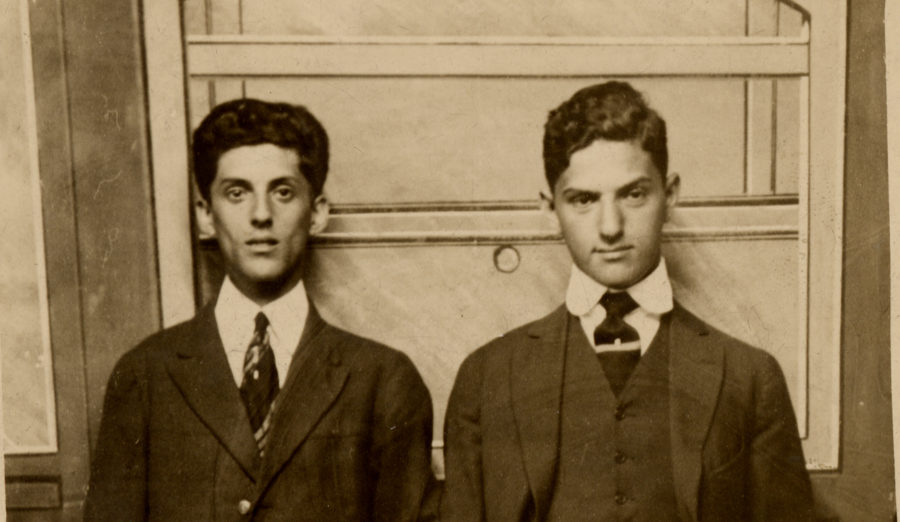Ira Gershwin on Walking
March 20, 2020
George Gershwin Ira Gershwin
Have you gone for a walk lately?
In this time of great uncertainty, and inspired by “Is It OK to Take a Walk?” Alex Williams’ wonderful New York Times essay of March 17, 2020, I’m reminded of some of Ira Gershwin’s early prose writing.
Ira (pictured on the right, above, with his cousin Henry Botkin around 1915) was an inveterate walker in the years before he led a much more sedentary life in Beverly Hills; these walks offered opportunities for him to observe people and listen to their language. These early explorations added to his ever-growing storehouse of words and phrases, many of which found their way into some of the hundreds of songs he wrote with composers from George Gershwin to Kurt Weill.
The following excerpts of Ira Gershwin’s writing come from two of his diaries: the first, entitled Everyman His Own Boswell, was written between 1916 and 1918 in New York City, years when Ira – then in his early twenties – was attempting to find his writing style; the second, which I’m currently editing and annotating as a volume of the Gershwin Critical Edition entitled The Gershwins Abroad, was kept during a visit to Europe in the spring and summer of 1928, by which time Ira was an established Broadway lyricist.
Here are the first few lines of observation, dated Tuesday, September 5, 1916, from Everyman His Own Boswell:
Took a walk thru the park (Central) yesterday. Found a great many of the walks in abominable condition. At the tennis grounds laid, (or is it lay, or what,) down and watch the Labor Day tennisites laboring under a warmish sun and a splendid sky.
Alex Williams’s essay notes that the streets of a big city are ideal locations for overhearing snatches of conversation. Here are a couple of the sentences that struck Ira’s fancy:
“You see the air is fulluv [sic] dust and that makes the sky blue.”
“And you ought to hear the terrible names she called me!”
Nine months later, on Saturday, June 23, 1917, he takes another walk, and sees a changing city:
Up 4th Ave. Looking over titles at bookstalls. 4th Ave. twixt 8th & 14th is becoming the 2nd hand book headquarters of the city. Around Union Square…. Then up 4th. Around Gramercy Park. Up 23rd. To park at 23rd St. Usual amount of speakers. Then Union Square on North Side a young eyeglassed lady haranguing a motley audience in Yiddish, something about striking, but goodness what a piercing voice, & what sound length radii she encircled!
Now a look at Paris from The Gershwins Abroad. On Friday, March 30, 1928, Ira left his hotel to roam the city streets with fellow lyricist Leo Robin:
So for a walk—(it had stopped raining about noon—for a miracle)— through Luxembourg Gardens. Then we walked over one of the bridges of the charming Seine over to the left bank. Walked along the bookstall section for five or six blocks, then into some narrow and very old streets (saw a house where a work of Molière’s had received its first performance) and continued to zigzag along for a couple of miles when, tired, we stepped into a café and had wonderful dark Strasbourg and sandwiches (four large glasses, four sandwiches totaled sixteen francs).
One week later, on Friday, April 6, 1928, Ira described the only stroll he took in Paris with his brother George, that included a memorable visit to a famous tourist spot:
In afternoon, George and I walked along Avenue Kléber, bought a lot of fruit, a quart bottle Cointreau and quart bottle of wonderful Spanish Port—all for six dollars. Walked to Trocadero, then over bridge to Eiffel Tower. There was quite a line, but we joined it, and in fifteen minutes were in the elevator along with some fifty others, all French excepting for about a dozen Germans, and an English tutor with two boys. It was eight francs apiece to le sommet. At the second landing, we changed to another elevator, then a few hundred feet higher to a third, which took us to the top. I had never been so high up in a structure (twenty-two stories or so was my highest in New York) and it was terrific. I was afraid to walk the few feet to the railing, but finally did. George complained of peculiar sensations in his stomach and other portions. The view of course is magnificent. We walked around kidding one another, but really greatly impressed. After five minutes or so, we took it more casually and leaned over the railings. I must say the other visitors seemed to take it very naturally, one couple making love, the girl giving the man what we called as kids, “feels.” George had a caricature made for twenty-five francs— not bad. Then down in the elevator to the second landing, from which we decided to walk. It was twenty-six flights down to the first landing, and twelve down from there—thirty-eight in all, and boy how my legs trembled when we finally got to the street. It took me three blocks’ walking to get them straightened out.
As we adjust our lives to this new situation of social distancing, let’s not forget to keep our eyes open and our minds alert. Even in the absence of foot traffic, there is much to observe. What can you see?
— Michael Owen